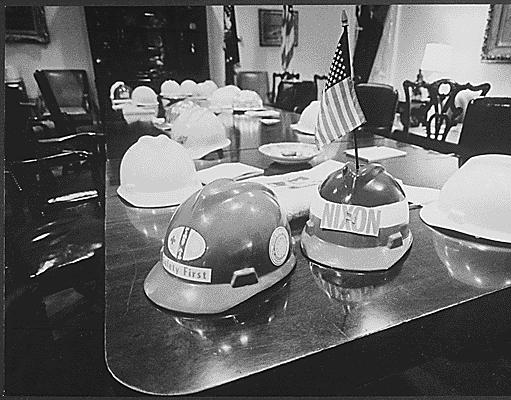


By Joe Guzzardi
04/23/2004
In the spring of 1970, I worked for Merrill Lynch on Wall Street as an investment banker.
By 1970, the Vietnam War had split American into two factions — the pro-war and the anti-war.
And few demonstrated tolerance towards anyone whose view was different than theirs.
Most afternoons, my friends and I took our brown bag lunches down to Battery Park to watch the Hawks and the Doves argue over what course in Southeast Asia the Nixon administration should take.
What we didn’t realize was that those super-heated, in your face disputes would boil over into one of America’s ugliest street brawls during an era when violent demonstrations were commonplace.
Within the Hawks and the Doves were two sub-groups: the Hard Hats, over-the-top patriotic construction workers who supported escalating the war and the Peaceniks, student groups who favored a complete and immediate withdrawal from Southeast Asia.
Oddly, I couldn’t relate to either group. Although I had only graduated from college a few years earlier, I had nothing in common with the longhaired, marijuana smoking protesters.
But neither could I sympathize with the Hard Hats. The war was going badly. In late April, Nixon had announced that troops would be sent to Cambodia. And on May 4, the National Guard shot and killed four Kent State students during a protest at the university.
Under the best of circumstances, the rhetoric between the Hard Hats and the Peaceniks was always on the verge punches. The Hard Hats called the college students "faggots," "Commies," and urged them to "go back to Russia."
The construction workers — correctly — took a dim view of the more extreme students who spat on and burned the flag and who forced campus shut downs.
But also among the Doves were hundreds of mainstream people who were beginning to put the Vietnam picture together…and didn’t like what they saw.
The first bloodshed came on May 6. Medical students from the Whitehall Medical Center ripped down an American flag on a Broad Street construction job. Several of the students were beaten up.
But on May 8, everything exploded. A major peace rally scheduled for noon on Wall Street drew a big crowd. Everyone expected trouble but we had no idea just how much raw violence we were about to witness.
Shortly after 12:00, the first wave of 200 construction workers arrived at the corner of Wall and Broad. Waving American flags, they all shouted, "America, love it or leave it" and "All the way, U.S.A."
My friends and I could sense what was coming. The Hard Hats pushed their way past a police line that offered no resistance, grabbed the demonstrators and started to pound on them. They hit them with helmets, pliers and wrenches.
An emergency first aid station was set up at the historic Trinity Church on nearby Broadway. More than 50 badly beaten demonstrators were treated.
By this time, the Hard Hats were nearly 500-strong. They stormed Trinity Church shaking and rattling the iron gates that surrounded the landmark.
The mob’s next destination was City Hall — about a mile up Broadway. The Hard Hats hated New York’s Mayor John Lindsey. The mayor was condemned as a "Commie Rat" and "Liar, Leftist and Lunatic."
That Lindsey had ordered City Hall flags to be flown at half-mast in honor of the four murdered Kent State students further enraged the Hard Hats.
Upon their arrival at City Hall, one of the Hard Hats went to the roof and, to massive cheering, raised the flag to full staff. Sidney Davidoff, acting in place of the absent Lindsey, bravely walked onto the roof and lowered the flag.
Incensed, the construction workers charged City Hall waving their fists and cursing.
Finally, acting out of sheer terror, Deputy Mayor Richard Aurelio ordered the flag back up again. The Hard Hats immediately broke out into song with their version of the Star-Spangled Banner.[ War Foes Here Attacked By Construction Workers, New York Times, May 9, 1970]
When he returned, Lindsey was furious at the failure of the New York police to provide protection for the demonstrators or to quell the Hard Hat uprising. Many police officers on horseback tacitly supported the Hard Hats and refused to take preventative action.
On May 21st, when nightstick-wielding police attacked 1,000 peaceful protesters at Bryant Park and 39th St., sixteen charges of police brutality were filed with the Civilian Complaint Review Board.
The two bloody weeks in New York from May 6th to May 21st is only one tiny chapter in the Vietnam saga. People who weren’t there to see the brutality unfold cannot fathom what it was like.

Looking back, several footnotes make the story even more incredible. Vice President Spiro Agnew sent a letter to Peter J. Brennan, president of the Greater New York Buildings and Construction Trades Council commending his members for "the impressive display in patriotism — and a spirit in pride of country that seems to have become unfashionable in recent years."
And President Nixon was duly impressed with the patriotic Hard Hats, too. Nixon invited Brennan to the White House on May 26th. There Brennan, twenty-two other union leaders and Nixon discussed world affairs for nearly an hour.
On the way out of the Oval Office, Brennan presented Nixon with a hard hat.
Although there were no official photographs to record the moment, I struggled with the image of Nixon in his blue suit, striped tie, starched white shirt and a construction worker’s hard-hat.
Thirty-four years later, the US is embroiled in a war in Iraq that, like Vietnam, offers no easy way out. As more young soldiers die, frustration will rise.
Whether we will see the likes of those three bloody weeks in May 1970 remains to be seen. But unless things improve in Iraq, we might.
Joe Guzzardi, an instructor in English at the Lodi Adult School, has been writing a weekly column since 1988. It currently appears in the Lodi News-Sentinel.